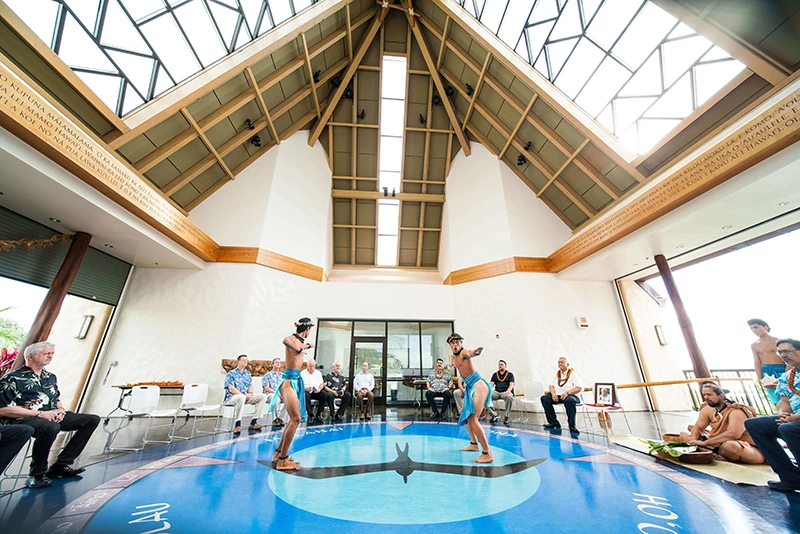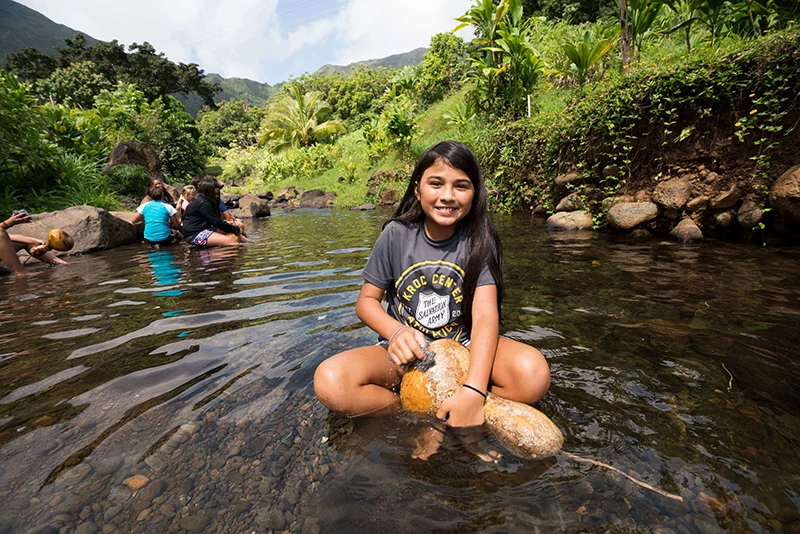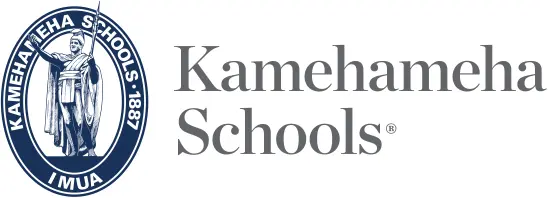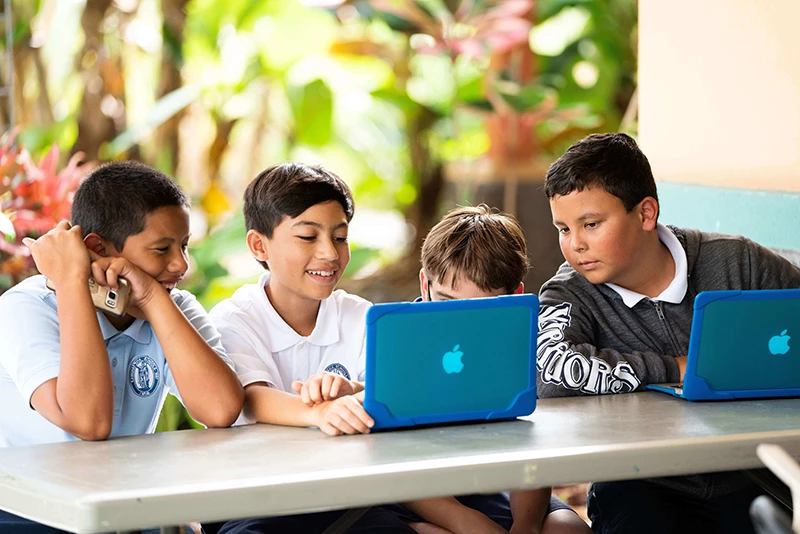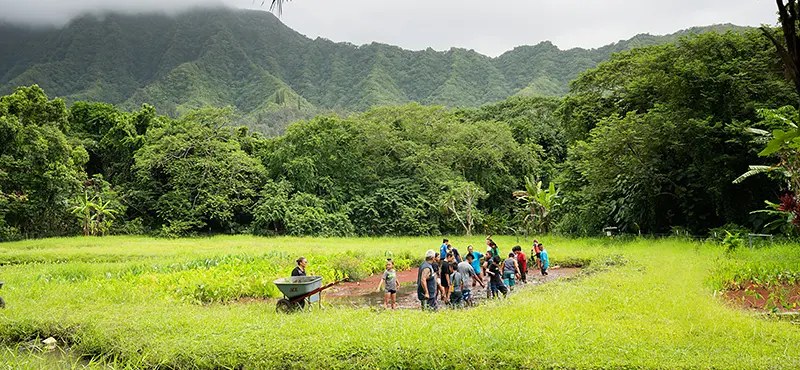For possibly the first time in generations, Native Hawaiian haumāna had a special opportunity to witness and speak to the oldest and largest known ʻōhiʻa lehua on Maui during this past Hālau ‘o Kapikohānaiāmālama (Summer and Extended Learning Program) at KS Maui.
A group of six high school haumāna and two kumu were guided on a three-mile hike through The Nature Conservancy's Waikamoi Preserve near Haleakalā National Park. The group was in awe as they reached the more than 80-foot-tall tree and 108-foot canopy.
“It was very cold, but it was worth it,” said Kaʻanohiulakala “Kimokeo” Puaa, a junior at Ke Kula Kaiapuni ʻo Kekaulike ma Maui. “I’m grateful I got to see Mama ʻŌhiʻa. I didn’t know I was gonna get to go on such rare hikes. Seeing that made me really proud to be Hawaiian and I’m really happy I took this class.”
Keoki Kanakaokai KSKʻ00, The Nature Conservancy natural resource manager on Maui, and field technician Marie Andres guided the class through the forest to reach the tree that could be up to 600 years old. Kanakaokai said he had tried to bring haumāna down the hike in previous summers, but was only able to reach it this year.
This ʻōhiʻa lehua is one of the few recognized Exceptional Trees in the County of Maui, a designation by the State of Hawaiʻi meant to foster preservation. Once the class reached the tree, haumāna led an oli and spoke in ʻōlelo Hawaiʻi.
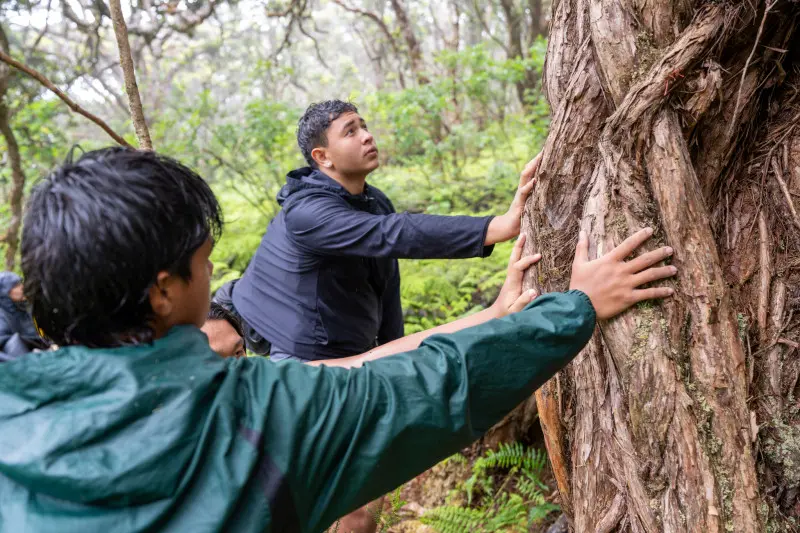
Haumāna Joseph Braceros (left) and Kaies DeMello place their hand on Mama ‘Ōhia, which is estimated to be up to 600 years old. During the class visit, haumāna led an oli and spoke in ʻōlelo Hawaiʻi.
Haumāna Joseph Braceros (left) and Kaies DeMello place their hand on Mama ‘Ōhia, which is estimated to be up to 600 years old. During the class visit, haumāna led an oli and spoke in ʻōlelo Hawaiʻi.
This excursion was part of the Lāʻau Hawaiʻi course, which used the Honolua ahupuaʻa as a living laboratory, in coordination with The Nature Conservancy and Puʻu Kukui Watershed Preserve. Haumāna acquainted themselves with plants and their influence on Hawaiian culture and history, plant biogeography and human migration, as well as the design and procedures of plant use in religious, medical and lifestyle traditions.
Peyton Cabudol, a junior at KS Maui, said she had not planned to take the class and jokingly referred to herself as “more of an inside type of girl.” She said she was surprised to learn more about native and invasive species on Maui and the impacts they have on the environment.
“If I’m being honest, my mom signed me up for this class,” Cabudol said. “But throughout the week it’s been really interesting and eye-opening. I didn’t realize how much was going on with our ecosystem. I’ve never been up here and it’s really calm and peaceful.
“Seeing that ʻōhiʻa tree I was like, ‘Wow she’s big.’ If we didnʻt have so many invasives, we could see our natives grow more.”
Joseph Braceros, a sophomore at KS Maui, said he was grateful to TNC and his kumu for the opportunity to experience the huakaʻi and touch Mama ʻŌhiʻa. He felt sad, though, about the amount of invasive plants and species in the area.
“I donʻt get to see this much of our island, so it’s almost like a once-in-a-lifetime chance,” Braceros said. “Seeing all the invasives, it’s really bad for our native ecosystem. I would like to try and help out as much as possible to see our natives thrive way more. Getting this ʻike from kumu will help me see what I can do.”

Keoki Kanakaokai (pictured from left), The Nature Conservancyʻs natural resource manager on Maui, poses for a photo with haumāna “Kimokeo” Puaa, TNC field technician Marie Andres, haumāna Kendrah Medeiros-Kiyonaga, Peyton Cabudol, Kumu Ululani Gouveia, haumāna Joseph Braceros, kumu Kalikopua Zablan, haumāna Kahoano Keahi and Kaies DeMello.
Keoki Kanakaokai (pictured from left), The Nature Conservancyʻs natural resource manager on Maui, poses for a photo with haumāna “Kimokeo” Puaa, TNC field technician Marie Andres, haumāna Kendrah Medeiros-Kiyonaga, Peyton Cabudol, Kumu Ululani Gouveia, haumāna Joseph Braceros, kumu Kalikopua Zablan, haumāna Kahoano Keahi and Kaies DeMello.
Kanakaokai said his goal was to help haumāna better understand the course curriculum, including ethnobotany, by using the “living labratory” of Waikamoi.
“The main thing I want to see is for these haumāna and kumu to build pilina with this place,” Kanakaokai said. “Meet our species, our kumu lāʻau and and kumu wai, and recognize them as relatives and sources. I wanted to have something for them to build a foundation on.”
Puaa appreciated the lessons he learned from the trip, including the ecological issues pine trees and other invaders present, and the ability for areas downstream of Waikamoi to receive water due to the invasive trees. He said he plans to “mālama the ʻāina more, plant more natives and share my knowledge with others.”

Haumāna Kahoano Keahi (from right) and “Kimokeo” Puaa observe the medicinal ʻalaʻalawainui alongside kumu Kalikopua Zablan during their huakaʻi into Waikamoi Preserve.
Haumāna Kahoano Keahi (from right) and “Kimokeo” Puaa observe the medicinal ʻalaʻalawainui alongside kumu Kalikopua Zablan during their huakaʻi into Waikamoi Preserve.
“My hope is that we wouldn’t have to walk as far to see natives,” he said. “Our natives would be right here at the entrance. It’s going to take a lot of time and patience, guarantee.”
Cabudol said she is interested in pursuing cosmetology school after graduation, but believed the class “opened her eyes to other careers and opportunities.” She said the trip got her out of her comfort zone and experience “breathtaking moments, literally.”
“I don’t do this kind of stuff, so coming out here I feel much more connected to my culture and my identity as a Hawaiian,” she said. “I am grateful to my mom. Sometimes you just need that nudge.”
Kanakaokai said he was proud and impressed by the group of high school haumāna as well as all the other classes from Hālau ‘o Kapikohānaiāmālama.
“These kids are our future leaders, you can tell just by being around them,” he said. “Not just the charisma, but their manaʻo, their ʻike and how they carry themselves. Even those who are not into it, they killed it. For them to go through all of that, it’s really impressive. Even if it doesn’t resonate with them right now, hopefully down the road it will.”

One section of the mostly native Waikamoi Preserve is still dominated by invasive species, including conifers from a remnant experimental plantation (pictured). Haumāna learned about the negative impacts invasive species have on Maui’s ecosystem and native plant life.
One section of the mostly native Waikamoi Preserve is still dominated by invasive species, including conifers from a remnant experimental plantation (pictured). Haumāna learned about the negative impacts invasive species have on Maui’s ecosystem and native plant life.
TAGS
maui campus,
ks maui,
native hawaiian identity,
aloha ʻāina,
ʻike hawaiʻi,
mālama ‘āina,
kūpuna wisdom
CATEGORIES
Kaipuolono Article, Regions, Maui, Moloka’i and Lana’i, Themes, Culture, Community, Employee ‘Ohana, Ka ʻohana Kamehameha, KS Announcements, Maui Newsroom, KS Maui Home, Newsroom, Maui, Alumni, Maui, Oiwi Leaders, Maui campus
Print with photos
Print text only

